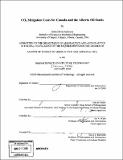| dc.contributor.advisor | John M. Reilly and Ian A. Waitz. | en_US |
| dc.contributor.author | Anderson, Justin David | en_US |
| dc.contributor.other | Massachusetts Institute of Technology. Dept. of Aeronautics and Astronautics. | en_US |
| dc.date.accessioned | 2008-11-07T19:00:28Z | |
| dc.date.available | 2008-11-07T19:00:28Z | |
| dc.date.copyright | 2008 | en_US |
| dc.date.issued | 2008 | en_US |
| dc.identifier.uri | http://hdl.handle.net/1721.1/43085 | |
| dc.description | Thesis (S.M.)--Massachusetts Institute of Technology, Dept. of Aeronautics and Astronautics, 2008. | en_US |
| dc.description | Includes bibliographical references (leaves 62-64). | en_US |
| dc.description.abstract | The threat of climate change proposes difficult problems for regulators and decision-makers in terms of uncertainties, varying exposures to risks and different attitudes towards risk among nations. Impact and cost assessments aim to alleviate some of these difficulties by attempting to treat the costs of inaction, regulation and adaptation.For such assessments to be relevant, they must deal with regions individually to estimate costs associated with different regulations since across regions the impacts from climate change and climate change regulation are heterogeneous. Canada, and her oil sands industry, is the focus of this CO₂ mitigation cost and climate change impacts study. Two Canadian policies, in line with the stated goals of the two largest Canadian political parties, have been modeled using MIT's Emission Prediction and Policy Analysis tool to better understand the costs of the policies and the emission reductions that they will achieve. Welfare losses reaching 3.3% (in 2050) for the goals outlined in the Canadian government's "Climate Action Plan" and 8.3% (in 2050) for the goal to meet Kyoto and post-Kyoto targets put forward by the opposition are predicted by the model. Oil sands upgrading/refining experiences severe carbon leakage while Oil Sands production is more resilient and may present less regulatory risk for investment. Gasification to produce natural gas substitutes could potentially be undermined by strict CO₂ policy unless optimistic carbon capture technology emerges. The results are highly dependent on whether an international carbon trading regime exists and whether bio-fuels emerge as a large scale, affordable, alternative to fossil fuels. The results are also dependent, to a lesser extent, on international CO₂ policy | en_US |
| dc.description.statementofresponsibility | by Justin David Anderson. | en_US |
| dc.format.extent | 64 leaves | en_US |
| dc.language.iso | eng | en_US |
| dc.publisher | Massachusetts Institute of Technology | en_US |
| dc.rights | M.I.T. theses are protected by
copyright. They may be viewed from this source for any purpose, but
reproduction or distribution in any format is prohibited without written
permission. See provided URL for inquiries about permission. | en_US |
| dc.rights.uri | http://dspace.mit.edu/handle/1721.1/7582 | en_US |
| dc.subject | Aeronautics and Astronautics. | en_US |
| dc.title | CO₂ mitigation costs for Canada and the Alberta Oil Sands | en_US |
| dc.title.alternative | Carbon dioxide mitigation costs for Canada and the Alberta Oil Sands | en_US |
| dc.type | Thesis | en_US |
| dc.description.degree | S.M. | en_US |
| dc.contributor.department | Massachusetts Institute of Technology. Department of Aeronautics and Astronautics | |
| dc.identifier.oclc | 244388130 | en_US |
